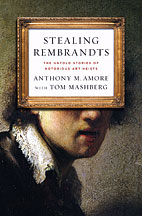Stealing Rembrandts: The Untold Stories of Notorious Art Heists by Anthony M. Amore and Tom Mashberg '82 (Palgrave Macmillan).

BAM Why did you focus on Rembrandt?
Mashberg Rembrandt has been stolen, we calculated, eighty-one times—if you count the [recent] one in California, eighty-two—over the last 100 years. That makes him the most stolen artist, second only to Picasso. Because Rembrandt seemed to be the focal point of the Gardner theft, we decided to look at every theft of Rembrandt paintings that we could find out about over the last half century. We wanted to see if there were any forensic commonalities between the theft at the Gardner and the others .
BAM Did you find any common denominators?
Mashberg Not really, is the short answer. We did not find any crime that was a mirror image or a match. But we learned things about the nature of art crime. We wanted to ask: How can it be that the most famous artist in history—and one of the greatest, without question—could be susceptible to so many thefts from so many museums throughout the world?
BAM So why are so many Rembrandts stolen?
Mashberg One is that there are enough Rembrandts out there. If you include his prints and his oils and his etchings, there are about 2,000 all told. You're looking at museums, galleries, and private collections, around the world, with very, very dissimilar levels of security, of caretaking, of experience with crime, of familiarity with how to secure art. Also Rembrandt's name is so famous that even the most low-level and art-ignorant criminal has heard of Rembrandt.
BAM Why is it so easy to steal art like this?
Mashberg You have the paradox that all museums face, which is the battle between keeping art accessible and keeping it from becoming vulnerable. After all, when you go into a museum, the last thing you want is to feel like you've entered into a Harry Winston jewelry store, or some sort of bank vault or armed camp. You want to commune with this art, within inches from it. You can't have shrill whistles and clanging metal doors that slam down any time someone gets within a foot of something. Given that, one of the most common methods that Rembrandt thieves use is the old snatch and grab. They just take it from the wall and off they go, right out the door.
BAM You interviewed Florian "Al" Monday, who orchestrated the 1972 Worcester Art Museum heist, and Myles Connor, one of the country's most notorious art thieves. What are they like?
Mashberg I definitely put Myles Connor in a category above most other criminals I've interviewed, because he really is well educated. He is extremely knowledgeable about arts and antiquities. He collects certain Japanese-type items, and he studies it very carefully. He taught himself Japanese while he was in prison.
BAM So most art thieves aren't that savvy?
Mashberg Really, the run-of-the-mill art thief is far less interesting or sophisticated than either of those two characters. Certainly at the time Monday stole the art, he didn't have much education in art. He was just a rough-and-tumble criminal and a fence, and he got in way over his head. He imagined he would be able to sell the stolen Rembrandt for millions of dollars right away, and lo and behold he discovered that he had no customers at all. For the most part you're dealing with second-rate characters—people who have just sort of graduated from breaking and entering and armed robbery at a gas station.
BAM Why would a gas station robber turn to art?
Mashberg A museum is, unfortunately, generally speaking, a soft target. That's what these guys are always looking for: soft targets. The idea that they're sophisticated characters out of the movies with erudition and tuxedos and contacts in rich circles in places like Monaco? That's all mythology.




